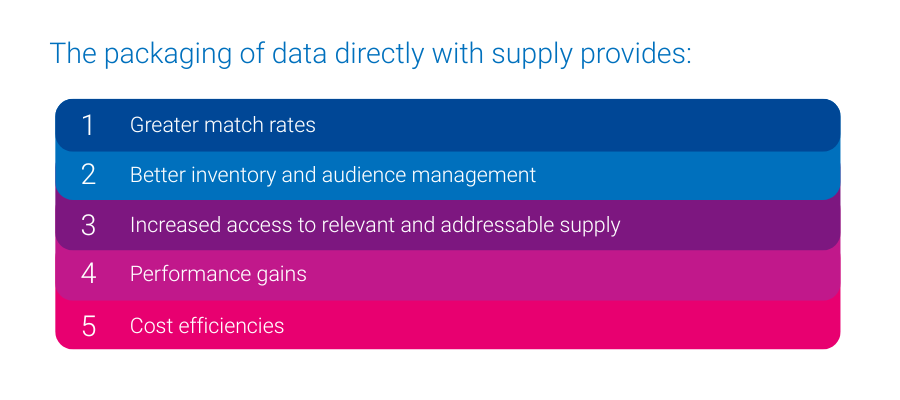
Audigent, a part of Experian, is excited to announce that curated audience and contextual inventory packages are now accessible on Google Display and Video 360 (DV360), delivered via Index Marketplaces. These premium deals offer industry-leading targeting solutions, combining high-quality data and inventory to enhance scale, value, and performance across connected TV (CTV), display, and online video (OLV).
The integration launches with over 250 ready-to-run deals covering various sectors, including some available for DV360 buyers for the first time, such as automotive, B2B, seasonal retail, sports fandom, travel, and weather, among others. Each deal combines exclusive audience data with premium inventory under a single DV360 deal ID. The supply-side activation lets you scale campaigns without cookies or device IDs, so results stay consistent even as traditional tracking disappears.
“We’re excited to expand Audigent’s curated, data-enriched packages in DV360 with Index Exchange. Putting Experian’s audiences and Audigent’s premium supply inside a single deal ID accelerates smarter decisions for marketers—letting brands activate, test, and see results right away.”
Chris Feo, Chief Business Officer, Experian
Why these packages stand out
Three reasons these packages drive results
- Signal-agnostic reach: Cookieless, device-less targeting preserves scale today and tomorrow.
- Instant activation: Traders simply add the pre-curated deal ID to a DV360 line item and go live in seconds.
- Built-in quality assurance: Exclusive audience data is paired with hand-vetted inventory, so you start closer to KPIs from day one.

Direct-to-source media buying that pays off
By packaging curated, data-enriched deals directly atop Index Exchange, via the Index Marketplaces platform, Audigent eliminates extra hops and integrates premium partner data into a single price, with no additional data management platform (DMP) fees. That means higher match rates, simplified audience management, and a cleaner, greener path that concentrates spend on top-tier publishers. Paired with Index Exchange’s omnichannel reach, brands see stronger performance and lower waste, no trade-offs required.
“Our goal with Index Marketplaces is to streamline access to premium supply, high-quality data, and measurable outcomes. Hosting Audigent’s ready-to-run deals on Index lets DV360 buyers tap addressable inventory curated for scale, sustainability, and speed – no extra steps, just better results.”
Paul Zovighian, Vice President of Marketplaces, Index Exchange
Real-world use cases
Audigent’s deep data collaboration bench isn’t window dressing; it’s baked into every package. Deterministic signals from Experian and fellow data leaders come pre-loaded, so you tap high-intent, high-match audiences the instant you activate a deal ID.
“This collaboration integrates The Weather Company’s industry‑leading weather forecast data into DV360, the world’s largest buying platform, enabling real‑time relevance through curated deals. Experian contributes deep expertise in consumer audiences, The Weather Company delivers unmatched precision in timing and location, and Index Exchange adds efficiency and transparency – together creating a streamlined, turnkey solution for activation.”
Dave Olesnevich, VP of Data and Ad Product, The Weather Company
Ready to activate?
Search Audigent in DV360’s Marketplace, select the Audigent package that fits your KPIs, and add the deal ID to your line item.
Prefer a custom build? Reach out to us at partnershipsales@experian to curate a package tailored to your campaign goals. The quickest path to performance is just one deal ID away.
Contact us now
Latest posts

In our Ask the Expert Series, we interview leaders from our partner organizations who are helping lead their brands to new heights in AdTech. Today’s interview is with Eric Shiffman, VP of Product Marketing at Yieldmo. Here are five key takeaways from Eric’s insights: Tailored campaigns with Experian data: Yieldmo integrates Experian’s trusted identity and audience data to deliver creative campaigns tailored to specific audiences, ensuring more meaningful engagement. Omnichannel activation made easy: Experian’s data marketplace helps Yieldmo expand its reach across display, mobile, and CTV, creating seamless cross-channel advertising strategies. Advanced targeting and insights: The combination of Yieldmo’s attention signals and Experian’s identity solutions allows advertisers to pinpoint audiences with precision and confidence. Driving results in key verticals: Retail, CPG, and automotive campaigns use Experian data on Yieldmo’s platform to achieve improved personalization, targeting accuracy, and measurable outcomes. Scalable and privacy-conscious advertising: Yieldmo’s partnership with Experian ensures scalable solutions that balance advanced targeting with privacy-focused practices, benefiting advertisers across all industries. About Yieldmo Yieldmo often describes itself as ‘the creative and media results company,’ using a predictive, provocative, and proven approach. Could you give us a brief overview of how this vision shaped the company and how you differentiate yourselves in ad tech? Yieldmo was built on the belief that every ad experience should be as engaging and human centered as the content around it. By merging creative excellence with advanced technology and AI, we enable advertisers to deliver custom ad formats that spark emotion and inspire action. Our proprietary attention signals and predictive format selection allow brands to optimize for outcomes before impressions are served. This approach, combined with privacy-safe inventory curation, ensures that our solutions stand out in their ability to deliver both creativity and results. Creative and inventory performance You’re known for delivering premium experiences across top-tier publishers. What strategies or innovations does Yieldmo employ to boost creative performance, increase engagement, and optimize inventory for your partners? At Yieldmo, we emphasize the fusion of creative and media. We utilize predictive AI and a vast dataset to generate, customize, and match creatives with the right audiences and page contexts, enabling proven performance and learnings. On the supply side, we elevate publisher inventory by aligning high-quality ads with relevant content in innovative, non-intrusive creative formats. This dual focus ensures that every impression is primed for engagement, delivering tangible value to advertisers and optimal monetization for publishers. Partnership with Experian As a partner of Experian, how do our identity and audience data complement Yieldmo’s platform, and why do you see this collaboration particularly beneficial for the broader advertising industry? Experian’s robust identity and audience data strengthen Yieldmo’s ability to serve precisely tailored creative experiences. By integrating Experian’s insights with our proprietary attention signals and AI-driven predictive systems, we can optimize audience targeting and engagement strategies. This partnership represents the advancement of outcome-driven advertising while giving brands the confidence of reaching the right consumers in meaningful ways. Interest in Experian's data marketplace Experian recently introduced a new data marketplace aimed at simplifying data partner audience activation across display, mobile, and CTV. Which elements of this offering are most exciting from your perspective, and how do you anticipate it shaping Yieldmo’s solutions? The unified approach of Experian’s data marketplace to streamline audience activation aligns seamlessly with Yieldmo’s vision of delivering data-driven creative optimization. The ability to activate comprehensive data sets across multiple channels expands our omnichannel solutions, bringing precision and scalability to advertisers. Lately, we have focused resources on delivering thoughtful, cross-channel creative experiences, so aligning audiences to those is a logical extension. Verticals using third-party data From your experience, which verticals or industries are most likely to activate third-party data campaigns on Yieldmo’s platform, and have you observed any emerging trends in how advertisers use data from Experian or other providers? The retail, CPG, and automotive industries have been leading adopters of third-party data, using it to fine-tune targeting and personalize their messaging. Recently, we’ve noticed a shift toward bringing more post campaign measurement insights to the supply side–brand lift, foot traffic, conversion–for better optimization, whereas historically this valuable dataset was trapped in buy-side platforms. Data utilization and success stories Could you share how Yieldmo’s data-driven approach has evolved and any standout success stories that highlight your platform’s impact and value to partners? Yieldmo has always prioritized data to inform creative decisioning, from predictive ad placements to real-time optimization. In this award-winning Humane Society case study, we utilized media curation and predictive creative to drive a >170% CTR increase, 5x the campaign benchmark, leading to more page visits and donations. Thanks for the interview. Any recommendations for our readers if they want to learn more? To learn more about our solutions and partnership opportunities, visit the Yieldmo website or contact your Experian account representative to schedule your free match test. Contact us About our expert Eric Shiffman, Vice President of Product Marketing, Yieldmo Eric Shiffman is a product marketing leader with extensive experience in advertising technology. At Yieldmo, he drives strategies that blend AI, creative optimization, and privacy-conscious solutions to deliver measurable creative and media results. Eric translates complex technologies into actionable messaging, positioning, and insights, and evangelizing products and solutions. His expertise spans creative optimization, data-driven advertising, CTV, and audience solutions. Latest posts

Originally appeared in Streaming Media Magazine Navigating today’s fragmented, privacy-conscious media landscape is a bit like stepping into a dense jungle. The buy-side—marketers, agencies, and demand-side platforms (DSPs)—must find their way through signal loss, measurement challenges, and evolving consumer expectations. But this isn’t just a challenge; it’s a strategic opportunity. Let’s dive into how buy-side players can use Experian’s advanced data and identity solutions to be their guide through the jungle and emerge as winners. Marketers: Maintaining personalization and measurement across channels Marketers are navigating an increasingly fragmented media jungle, where the deprecation of signals like cookies, mobile ad IDs (MAIDs), and IP addresses makes finding and understanding audiences feel like guesswork. To chart a clear path, marketers need a reliable compass—and identity resolution provides exactly that. A strong identity provider, grounded in offline data like names, addresses, phone numbers, and emails, acts as a guide through the chaos. By connecting offline signals with digital identifiers in a privacy-first manner, marketers can uncover the relationships between households and devices, then enrich those profiles with valuable marketing data. With a complete view of your customers, you gain deeper insights and can seamlessly reach the right audience across channels—even as signals evolve. It’s a marketer’s North Star—constant, dependable, and always pointing you in the right direction. How Experian can help Imagine a financial services brand aiming to connect with high-net-worth individuals across today’s fragmented media world. They’ve excelled on social and search but now want to dive into connected TV (CTV) and other emerging channels. Enter Experian’s Digital Graph. By seamlessly connecting digital identifiers like MAIDs, CTV IDs and hashed emails (HEMs), our graph becomes the bridge that unifies their audience across every channel. Suddenly, the same audience that saw their ad on social during lunch is now watching a personalized spot on CTV that evening, all thanks to Experian. The result? A cohesive campaign that delivers hyper-relevant messages, stronger engagement, and measurable success. With Experian, fragmentation becomes connection, and personalization stays powerful across the entire media landscape. Agencies: Strategic partners in a fragmented world Agencies are the architects of the identity jungle, building bridges that guide brands through fragmentation and deliver campaign success. Thriving in this terrain requires data solutions that create actionable insights, enable personalization, and drive measurable outcomes. To meet marketers’ demands, many agencies have invested heavily—acquiring data companies or forging strategic partnerships to strengthen their foundations in data and identity solutions. These investments help them connect fragmented audience data and unlock new opportunities for their clients. But even with in-house capabilities, agencies often need more—more attributes, more integrations, and greater connectivity. In the jungle of identity, success isn’t just about building better data assets; it’s about ensuring those assets can be utilized across platforms. How Experian can help Picture a large independent agency ready to step up its game—expanding beyond its middle-market niche to attract enterprise-level clients. But to play in the big leagues, they need more than a solid strategy; they need data and identity solutions that deliver a competitive edge. Enter Experian. With our rich identity graph and deep customer insights, the agency can unlock new opportunities for its clients. Imagine offering enterprises the ability to connect fragmented audience data, create hyper-targeted campaigns, and measure success across every channel. The payoff? The agency doesn’t just win over new enterprise clients; it strengthens relationships with existing customers by proving it can navigate today’s fragmented media landscape with precision and measurable impact. With Experian, the agency becomes an indispensable strategic partner in the data-driven advertising world. DSPs: Navigating signal loss with a multi-ID strategy For DSPs, navigating the identity jungle means forging a path through the winding trails of cookieless strategies. With third-party cookies fading and no single identity solution—like Unified ID 2.0 (UID2)—able to cover all media engagement, DSPs must adapt to a multi-ID world. The challenge is twofold: finding flexible solutions to manage a multitude of identifiers while staying compliant with a growing number of state-level privacy laws. It’s not just a technical problem; it’s a call for strategic vision. And the way to thrive in this ever-changing terrain is to invest in identity solutions that connect digital and offline identifiers to a single customer profile. How Experian can help Imagine a DSP navigating a complex web of identifiers—UID2, HEMs, proprietary IDs—while juggling compliance with evolving privacy laws. Experian steps in as the ultimate connector. Our identity solutions, powered by stable offline data, are signal-agnostic and integrated across the advertising ecosystem. This ensures that DSPs can confidently manage multiple identity frameworks, keeping campaigns targeted, measurable, and compliant. With Experian, DSPs gain more than a stopgap solution; they get a future-proof identity strategy. The result? Better targeting, smoother omnichannel execution, and the strategic edge needed to thrive in a fragmented, multi-ID world. Turning identity challenges into a strategic advantage The identity jungle is a thriving ecosystem for those with the right guide. Experian helps marketers, agencies, and DSPs chart the course by unifying multiple identifiers into a single, complete customer profile. With the right tools (and a good map), buy-side stakeholders can learn more about their customer, reach audiences across channels, and deliver personalized marketing. Read our companion article to learn how the sell-side is approaching data and identity challenges. Read now Get started today Latest posts

We spoke with industry leaders from Ampersand, Basis Technologies, Captify, Cuebiq, CvE, Fetch, Madhive, MiQ, and Samsung to gather insights on how innovations in data and identity are creating stronger consumer connections. Here are five key insights to consider. 1. Build on trust with first-party data Stricter privacy regulations and growing customer expectations mean businesses must rethink how they gather and use data. A robust first-party data strategy centers on gathering high-quality data, such as behavioral and transactional data. By using behavioral, lifestyle, and purchasing data, brands can craft personalized strategies that align with their goals. This approach balances effective targeting with building trust and complying with privacy rules. Integrating identity solutions like Unified I.D. 2.0 (UID2) and ID5 into existing data strategies improves interoperability across platforms while keeping user privacy intact. These tools help create more effective campaigns. "We've been preparing and leaning into educating our clients around the value of first-party data. These are very important and primary considerations in any of our campaigns."April Weeks, Basis Technologies 2. Align metrics with business goals To demonstrate clear value, campaigns need to tie their outcomes to broader goals. Relying only on click-through rates or CPMs won’t cut it. Metrics that measure meaningful results, like driving sales or increasing customer retention, provide greater transparency than surface level data, like clicks or impressions. A continuous feedback loop between targeting and measurement ensures campaigns can be refined to better align with business objectives. This feedback helps marketers understand who they are targeting and how those audiences are driving key business results. Shifting focus to metrics that resonate with stakeholders ensures that marketing efforts are evaluated based on their true contribution to the company's objectives. "The television industry has access to more data than ever before, and at Samsung Ads, our ACR technology helps us provide valuable insights about what content and ads are being viewed. This abundance of data enables us to support clients in aligning their campaigns with business objectives effectively."Justin Evans, Samsung Ads 3. Personalize experiences to boost engagement Personalization drives stronger customer relationships by delivering tailored experiences to individual customer needs. Using data-driven insights to fine-tune offers and messaging makes interactions more relevant, strengthening brand loyalty. Combining behavioral, lifestyle, and transactional data provides a comprehensive understanding of the customer journey and ensures each touchpoint feels personal. Testing and iterating on personalization strategies also helps identify which data and approaches yield the best results. Scaling these efforts means customers receive the right messaging at the right time, and businesses see better outcomes. "Every business should be building a data strategy that thinks about the different versions of data that exist and how they bring that together. They don't necessarily need to own all of it but have a clear rationale and strategy about where you're using which data sets."Paul Frampton, CvE 4. Utilize advanced measurement tools for smarter decisions Improving the effectiveness of campaigns starts with using sophisticated measurement tools to gain actionable insights. Using analytics like brand lift studies, foot traffic analysis, app download tracking, incrementality, and share of search allows marketers to understand the full impact of their efforts. With these resources, teams can pinpoint what’s working, make real-time adjustments, and refine their approach. This adaptability ensures budgets are used as effectively as possible. Learn how Swiss Sense measured marketing outcomes using Mosaic® "We are playing a leading role in democratizing new tools for local advertisers. By mimicking the marketing funnel mentality, we've introduced solutions ranging from measuring brand lift to tracking foot traffic and app downloads."Luc Dumont, Madhive 5. Adapt quickly to stay competitive The only constant in advertising is change. Adapting quickly to new technologies and consumer behaviors keeps businesses competitive. A culture of agility fosters innovation, making it easier to respond to industry shifts and discover new opportunities. Companies that anticipate change and invest in modern data solutions position themselves for long-term growth. Whether it’s adjusting to privacy updates, exploring emerging tech, or staying flexible, businesses must continuously invest in adapting their platforms and strategies. "Falling behind is not really an option. There's always a change in advertising and in data where there's a new horizon. The people who stay close to that and innovate will always follow it."Amelia Waddington, Captify Shaping the future Building meaningful consumer connections requires advertisers to combine robust data strategies with flexibility and innovation. By focusing on these five considerations, marketers can adapt to today’s challenges while preparing for what’s ahead. Connect with our experts Latest posts







